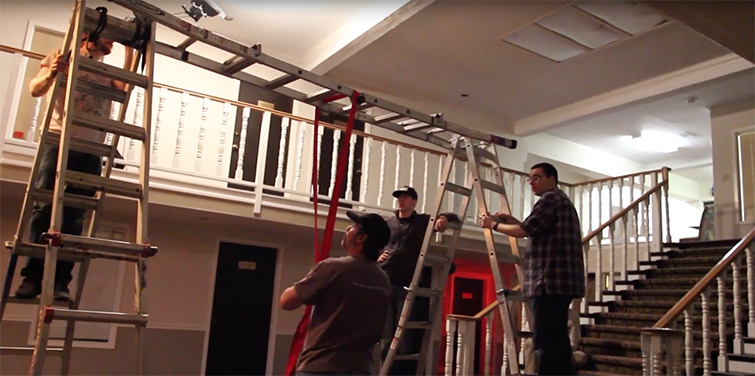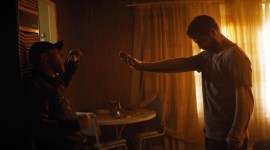
Production Tips: Getting Started with Low-Budget Stunt Coordination
Need to (safely) coordinate some stunts for your next project? Here’s what you need to know to get started in the wild world of stunt coordination.
First and foremost, stunts are dangerous. All stunts. Whether it’s running from a giant explosion or slipping on a wet tile floor, stunts can result in injury or even death — even when planned properly. This article is for educational purposes only.
Stunts are exciting! They can add a real sense of danger to a fist fight when suddenly Wham! the hero gets suplexed through a table. They can add physical comedy to catch the audience off guard, like a character falling out of his chair unexpectedly. Stunts can also add a nice level of production value. But that doesn’t mean that all stunts have to be expensive.
Now, blowing up buildings and flipping cars is beyond the scope of this article. Here we will go over a basic introduction to stunt coordination and some small-but-exciting stunts for low budgets.
Stunt Coordination
So what is stunt coordination? Stunt coordination involves safely planning out and executing stunts, such as falls, fights, chase scenes, etc. The stunt coordinator needs to work with the director, cinematographer, and often even the production designer and costume department in order to plan out the safest way to pull off a stunt — big or small. Emphasis on safest!
Remember, film is all about illusions. Yes, practical stunts are real and dangerous; they depend on meticulous planning. Also keep in mind that the stunt needs to be safe enough to perform multiple times. Maybe your stunt double is tough and totally cool with taking that big hit and getting winded and bruised — or whatever. But if they can’t do it multiple times, or if doing it multiple times will injure them permanently, then it’s no good. No film project is worth death or permanent injury.
So how can we pull off some impressive-looking stunts on a tight budget and still be safe? With planning and coordination.
Planning and Coordination
If you’re using a stunt double, I’d recommend checking out my previous article on how to maintain the stunt double illusion.
Let’s go over two types of falls: one with gym mats and one with wires. For either one, it’s always good to have your stunt double wear some kind of padding on their body. Some reliable, low-budget padding is available online or from you local sporting goods store. Get some compression padded shorts to protect the hips and tailbone and some knee and elbow pads if you plan any stunts involving either of those. You can also purchase a low-cost motorcycle spine protector. Foldable gym mats are available at Amazon for a decent price.
For this first example, use the spine protector. In this stunt, my character gets lifted and slammed through a table and knocked out.
Let’s break this down. Framed just out of shot are a series of pads beneath the table. The table itself is cheaply made (particle board), and we removed all the supports. This allows for the table to effortlessly break as I pass through it (another method, if you’re able to afford it, is to either buy or make a breakaway table from balsa wood). Take note, as I pass through it: my co-actor is holding onto me the entire time and merely guiding me through the table. He is using some force, but he is not slamming me. This is important because even with pads and a breakaway table, getting slammed into the ground can cause some serious injuries.
The natural pull of gravity and a bit of acting is what sells the table crash.
The second example requires hip pads.
In this stunt, my character gets kicked clean off his feet and falls straight to his side, bewildered. This stunt involves some wire work. As you can see, the wires have been removed digitally. We locked down the camera, did our stunt work, then cleared everyone out and shot a clean plate. I used the plate to cut out all the crew and equipment hoisting me up and dropping me to the floor.
The rig is simple enough. Three strong ladders are securely bound together in the form of an archway and supported by my crew. A simple pulley system is attached to a harness that I’m wearing beneath my clothing and above my hip pads. My stunt coordinator suspends me in the air for a brief moment before dropping me to the ground as I get kicked, and then drops me. Yes, I do take about a four-foot drop to my side, but notice that I am still in control of my head (as to not whiplash or slam it into the ground and concuss myself).
The wire is strong Paracord. Body and waist harnesses are available fairly cheaply (and they’re safe enough for small stunts like these). For an in-depth guide to digital wire removal, check out the following video. (Using masks is great for getting rid of big details and rigs, but I found the Photoshop method discussed in the video to be best for the wires themselves.)
When dealing with any kind of rig like this, make sure you test it out! Attach a weighted bag, stress test it in a way that if it does fail no one will get hurt. Test it during pre-production; test it on set. You need to be sure your rig will stand up to rigorous and repeated use before attaching a person to it.
Advancing
Stunts are exciting! Performing, directing, and coordinating them is genuinely thrilling and satisfying. Start small and build. Always plan safely, never take shortcuts. See how you can use the camera to make even mundane stunts look spectacular. Experiment. Use padding whenever possible. If anyone feels unsafe about the stunt, then don’t go through with it. Go back to the drawing board and come back when you know you can do it safely.
Looking for more film and video production tips? Check these out.






